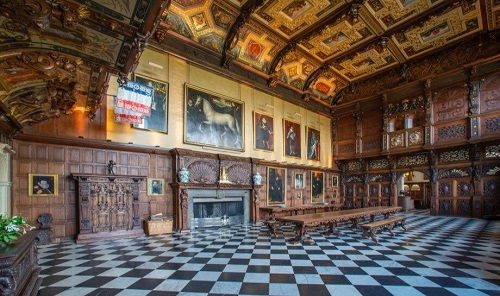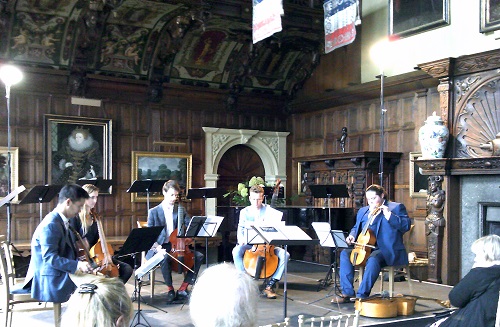The extravagantly carved Marble Hall at Hatfield House, which is named after its black-and-white chequered floor, remains much as it was when Robert Cecil, the 1st Earl of Salisbury, built it in 1611. Opposite the entrance hangs the famous ‘Rainbow Portrait’ of Queen Elizabeth I, a painting rich in symbolism whose motto, ‘Non sine sole iris’ (No rainbow without the sun), identifies Elizabeth as the sole bringer of peace.
Each year the Festival celebrates some of the musical history of the house and this year the focus has been on works composed during the reign of Elizabeth I. The Hall was thus a fitting venue for us to gather to enjoy a performance by Ensemble Pro Victoria, directed by Toby Ward, and the Arculo Consort of Viols, directed by Matthew Farrell, which marked the quarter centenary of William Byrd (1539/40-1623), offered works by his contemporaries Orlando Gibbons and John Bull, and celebrated the past by creating the new.

The programme was introduced by William Hunt – founder member of Fretwork, now principal violone with the Dunedin Consort and director of The Gibbons Project – who earlier in the morning had presented a pre-concert talk exploring the recital repertoire. Director Toby Ward was not averse to adding his own thoughts about the programme, nor to abandoning his ‘podium’ and joining his singers, relishing the tenor lines and communicating with such vividness – a terrific example to the ensemble – that it sometimes felt as if he might start conducting the audience. The result was a refreshing spirit of conviviality and collaboration, the informality of which in no way lessened the ‘seriousness’ of the musicians’ intent or communication.
We began with Byrd’s full anthem, O Lord, make thy servant Elizabeth our Queen. It took the vocal and instrumental groups, understandably, a little while to settle into each other’s grooves, and to find an appropriate balance of voices and instruments. Singing with single voices to each part is always challenging, but I’d have liked (indeed, throughout the performance) a little more ‘top’, which might have given the anthem more brightness and majesty. The rich counterpoint really needs to sound bursting with optimism and hope. The extended final “Amen”, though, was soothing, as one felt the voices relaxing and softening. The late consort anthem Have mercy upon me, O God, in which the verses were sung with purity by soprano Fiona Fraser, made the most of Byrd’s expressive changes of timbre and, following the plea to “Wash me clean from my wickedness, and purge me from my sin”, the final “Amen” rang darkling and deeply. Notable, too, was the way the viols maintained an imitative dialogue with the voice, intertwining with interesting harmonic effect.
Fraser was also the soloist in Byrd’s In angel’s weed I saw a noble Queen, a consort song which mourns the death of Mary Queen of Scots in 1587. The clarity of her voice against the grain of the viols was no less expressive than the rich fullness of her middle range, which she used to heighten the text, “By false suspect and jealousy of those whom fear had wrought to be her mortal foes”.

From Orlando Gibbons (1583-1625) we began with See, see the word is incarnate, in which tenor David de Winter led the solo verses with strong projection and communication; his interpretation of the rich imagery, “the prick of thorns, the print of nails” was particularly impressive in the nuance and drama it conjured. The ensemble episodes built impressively through the anthem, with pivot points such as “Sing Alleluia” nicely vivified; but I’d have liked more verbal clarity – particularly as Gibbons’ anthems reflect, perhaps more than any other composer, the concern of Protestant reformers of the era that the words of the scriptures should be unambiguously heard and understood. That said, the final section was rhythmically vigorous and the final “Amen” confident, as the voices floridly explored some unusual harmonies.
The tender acapella opening of the well-known Drop, drop slow tears was beautifully placed, the viols echoing the vocal phrases, varying, extending and deepening the means of expression. I liked the way that Ward introduced just the slightest of breaths, “to cry for vengeance / sin doth never cease”, thereby subtly emphasising these emotive nouns, and releasing a flood of decorative tears from Matthew Farrell’s treble viol. Farrell – who as well as directing the Arculo Consort and performing with Rosafresca, specialists in early English and Spanish music, also sings as a Layclerk at Westminster Cathedral – joined Ensemble Pro Victoria for Gibbons’ 8-voice anthem, O clap your hands, in which the rhythms were incisive, the mood festive, the momentum never flagged and the varied episodes were effectively structured.

As well as joining in consort with the voices, the Arculo Consort also presented masterly examples of two of the central instrumental forms of the age: the Fantasia and In nomine. The Fantasia III of John Jenkins (1592-1678) is one of more than 800 instrumental works that he composed, his most exquisite music being that for viol consort. Arculo produced a lovely blended sound, the trebles sweet, the tenors nuanced, the bass rich and full. Gentle imitation unfolded in an effortless stream. Perhaps something when slightly amiss towards the close? But, the ensemble brought things together for a poised close. Byrd’s In nomine a5 begins with gently falling phrases, and as the players entered in turn it seemed as if they were picking up musical lines that were already playing elsewhere. Increasing movement and complexity ensued, over a sustained bass tone, and the music acquired assertiveness and splendour as it approached the concluding triumphant arpeggio figures.
As mentioned earlier, there were also two new celebrations of the Elizabethan idiom and age: bass (and Pro Ensemble Victoria’s composer-in-residence) Piers Connor Kennedy’s Follow your Saint and On Monsieur’s Departure. The former sets text by Thomas Campion in which the poet-speaker muses over their unrequited love; the latter is a setting of text by Elizabeth I, thereby creating a hypothetical dialogue between the two works.

David de Winter was again the tenor soloist in Follow your Saint, coping well with the fairly low register and alert to the idiomatic rhetoric that Kennedy injects into the score – the dissonance and pointed rising motif which make tangible the poet-speaker’s suffering in the first stanza, for example: “But is she scorns my never-ceasing pain”. The viols brought an assuaging softness to bear on the image of “The music that her echo is and beauty’s sympathy”; and an expansion of phrase length and dynamic at the close promised fulfilment of a very Elizabethan kind, blending love and death and sealing this union with a tierce de Picardie of promise: “Then let my notes pursue her scornful flight:/ It shall suffice that they were breath’d and died for her delight.”
Kennedy reproduces similar harmonic-textual patterns and phrasing in On Monsieur’s Departure for six voices and viol consort. Essentially, regularity of harmony and scansion might result in an unexpected twist at a cadence, or slippage onto an ‘open’ chord with added seventh or ninth; a more irregular phrase might conclude with a consoling harmonic unity. It’s not an ineffective conceit, and is deepened by other expressive means: the viols’ mournful dissonances that plunge deep and dark at the start; pointed musical imagery – “I freeze and yet am burned”, the drawn out resolution which conveys the struggle to suppress passion and rid it from the speaker’s breast. The final stanza flows gently, making the sharp dissonance on “kind” (“Or be more cruel, love, and so be kind”) a piquant paradox. The falling appoggiaturas which colour the image of “sweet content” in the penultimate line prepare for the nostalgic weight of the low viols which conveys the resignation of the close, “Or die and so forget what love ere meant”.
We returned to Byrd to close the recital. Christ Rising Again, from the 1589 Songs of Sundrie Natures, demonstrates Byrd’s complete mastery of the verse anthem form and, despite a brief false start, quickly corrected, the two ensembles demonstrated their own mastery of the idiom, the short interjected choruses bursting with life and colour, Ward creating momentum with fluid movement between simple and cup-common pulses, and the shift to triple meter adding to the vibrancy and impetus. The homophonic restraint of “Death from henceforth hath no power upon him” was swept aside by the triumph faith “in Christ Jesus our Lord”.
Of the symbols in the Rainbow Portrait, some of the least subtle are the eyes and ear that are embroidered into her dress. If the implication is that she sees and hears all, then one can presume that she would have approved of this musical homage.
Claire Seymour
Ensemble Pro Victoria: Toby Ward (director/tenor), Fiona Fraser (soprano), Elisabeth Paul, Joy Sutcliffe (mean), David de Winter, James Robinson (tenor), Piers Kennedy (bass)
Arculo Consort of Viols: Matthew Farrell (director/treble viol), Tim Burton (treble viol), Sarah Small & Cai Waverley Hudson (tenor viol), Tim Edwards (bass viol)
Byrd – Our Lord, make thy servant Elizabeth our Queen, Have mercy upon me O Lord; Gibbons – See, see the Word is incarnate; Jenkins – Fantasio III; Piers Connor Kennedy – Follow your Saint; Byrd – In angel’s weed I saw a noble Queen; Piers Connor Kennedy –On Monsieur’s Departure; Gibbons – Drop, drop slow tears;Bull – The Starr Anthem: ‘Almighty God, which by the leading of a star’; Gibbons – O clap your hands; Byrd – In nomine a5, Christ Rising Again.
Marble Hall, Hatfield House, Hertfordshire; Sunday 1st October 2023.